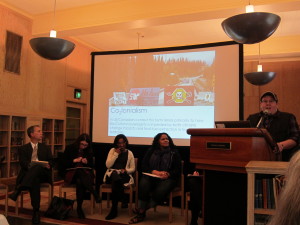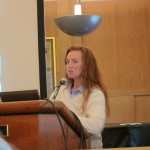Notes on “Rethinking Race and the Anthropocene”
By April Anson
University of Oregon, May 7-9th, 2015
As the first ever event of its kind, Rethinking Race and the Anthropocene marked an important methodological and epistemological moment in interdisciplinary work on environmental issues.
Bringing together scholars from diverse disciplinary backgrounds, community outreach activists, graduate students–and even one undergraduate presenter–the symposium consisted of four panels and structured conversations accompanying the two keynote presentations. Throughout the symposium, topics often moved between–and connected–the theoretical and the pragmatic. This began with rigorous investigation of the use value of the term “Anthropocene†itself to localized resilience efforts to bring university faculty and students together with communities to work against the slow violence of industrial waste.
Overall, the conference organizers hope to maintain a sustained cross-disciplinary conversation that focuses on the intersectionality of racializing and ecocidal systems, and their implications for work in the face of climate change, environmental toxicity, and social/environmental justice concerns. Below, I briefly summarize the panels, themes, and keynotes. Though I recognize no synopsis will be adequate to communicate the depth of exchange that took place, I do hope to re-seed some of the vision here.

From left to right: Panelists David Vázquez, Julie Minich, Naveeda Khan, Jennifer James, and J Bacon
Opening the symposium with a few framing comments, organizers Stephanie LeMenager, Marsha Weisiger, David Vázquez, and Sarah Wald each expressed excitement for the opportunity to think together about the relationships between race, environmental devastation, and anthropogenic climate change. Thursday hosted the first panel “Rethinking Race/Ethnicity in the Anthropocene†with Naveeda Khan (Johns Hopkins U), Julie Minich (U Texas Austin), J Bacon (U of Oregon), and Jennifer James (George Washington U). This panel coalesced around the strength of vulnerability, healing through recognition of pain, and the rhetoric of CO2lonialism. This conversation also contested the continued use of the term “Anthropocene,†identifying its homogenizing speciesism and implicit inattention to the importance of colonialism, capital, and slave labor to the economies of environmental destruction. The panel was followed by a keynote from Professor Julie Sze of UC-Davis, whose talk, “Environmental Justice, Visibility, and Recognition in the Anthropocene,†attempted to center a decolonial visual politics of the Anthropocene through recognizing that a failure to see is closely linked to a failure to act. Working within Rob Nixon’s slow violence and James Scott’s notion of “seeing like a state,†Sze argued that art has the potential to highlight the most unseen, most unknown elements of both slow and fast terror. Challenging a liberal politics of empathy and recognition, Sze emphasized the importance of a transformational empathy moving beyond acknowledgment to the importance of inequality, difference, and self-recognition. After her talk, Sze was joined by Kari Norgaard (U of Oregon), Nicolae Morar (U of Oregon), and Taylor McHolm (U of Oregon) for a structured conversation regarding how power works and ways of conceiving of justice beyond the distributive model.
Friday began with moderators Marsha Weisiger and Matt Dennis introducing the “Historical Perspectives on the Anthropocene†roundtable featuring Nancy Langston (Michigan Tech U), Robert Figueroa (Oregon State U), Bob Wilson (Syracuse U), and Dan Platt (U of Oregon). This panel covered the legacies of environmental collapse such as floods, as well as social justice movements in consideration with their attendant rhetoric, resettlement, and literary past. In order of mention, these scholars asked the audience to consider terms such as “restoration justice,†“environmental identities,†and the significance of Cornel West’s recent coinage of a “planetary Selma,†and also reimagine Moby Dick’s main character as Captain Anthropocene. Mark Carey and Stephanie LeMenager moderated the next panel, “Science and Climate Justice.†Presenters Megan Fernandes (Concordia U), Janet Fiskio (Oberlin College), Anne Nolin (Oregon State U), and Terry Hunt (U of Oregon) discussed representations of the Ebola outbreak and its connection (via outbreak and intimacy) to the phenomenon of the cat café in Japan, the persistence of plantation landscapes in continuing to structure the logics of disaster in Africatown, Alabama, and neoliberal economies both underlying and affected by climate change.
Friday’s symposium concluded with the commanding voice of artist and professor of visual arts at UC San Diego, Ricardo Dominguez. Dominguez discussed his history with the Electronic Disturbance Theater 1.0/2.0, the b.a.n.g. lab, and the Particle Group. Dominguez began by asking “Who put the “scene†in the Anthropocene?†and reminded the audience that “the anthrobscence and the capitalocene-Chthulucene†shows us that “life on this planet is one of planned obsolescence.†By rejecting utopia and apocalypse early on, Dominguez and his colleagues established the aesthetics of disturbance. Further, Dominguez presented recent work like the The Transborder Immigrant Tool, a global positioning system that becomes a geo-poetic system where poetry “dissolves†the US, and The Palindrone, which chases US border drones. Focusing on the transformative potential of art broadly conceptualized, Dominguez inspired the audience with his booming voice, unsettled notions of art and technology, and modeled recognition that a certain type of extinction must take place because “a certain type of people must become extinct.†Dominguez then participated in a structured conversation with Tara Fickle, Gerardo Sandoval, and Amy Harwood. I cannot speak for the entire audience, but I would be surprised if there was anyone in the room not changed by him.
The symposium concluded with the “Racial Justice and Indigenous Perspectives on Climate Justice†panel featuring PNW community organizers Sweetwater Nannauck (the leader Idle No More in Washington), Donita Sue Fry from Native American Youth and Family Center, and Vivian Satterfield, the Deputy Director at OPAL Environmental Justice Oregon. In fitting recognition of the importance of centering people of color and indigenous perspectives in discussions of environmental justice efforts, these women discussed the work they do – importantly declaring their endeavors be considered “activism†but cultural practice. Following a quote that has often accompanied the Idle No More movement, these women exemplify what it is to declare, “I am no longer accepting the things I cannot change, I am changing the things I cannot accept.â€
Let Rethinking Race and the Anthropocene continue to amplify that statement.
April Anson is a PhD student in Literature and the Environment at University of Oregon. Her work focuses on indigenous, environmental, and bio- politics in 19th Century American literatures, with secondary interests in scholarly activism and the tiny house movement.
